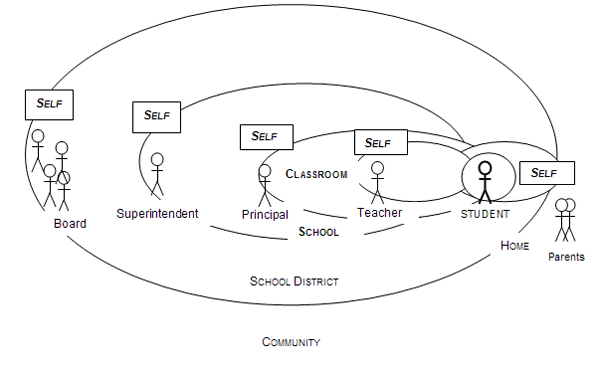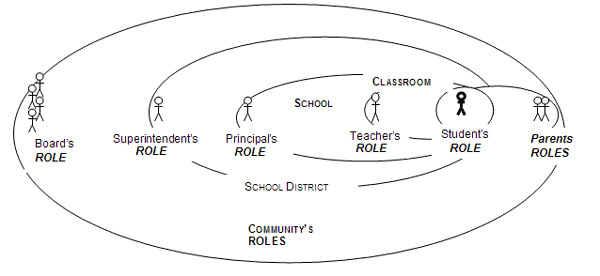New Understanding: A needed Role map
Regardless of the “sector” we work in, when we go to work each day we encounter a tension between the “job” we were hired and are held accountable for, and the “role” that in-the-moment conditions call for. Most powerful is that latter requirement because the roles we play at work are defined not only by that system of forces to which we must respond, but also by our internal values, strengths and commitments. What we want to do.
In schooling, everyone gets caught in the seemingly-opposing pulls of these two needs – teachers, board members, principals and district leaders. The way we have understood the problem has limited our solutions to ways that align to the job standards of individuals, not to the roles the system’s performance requires regardless of who is in them.
Unfortunately, organization charts display jobs, not the roles the people in it must responsively fill if the system is to do its job. Here’s how the lens can support thinking about a more natural alignment of the “jobs” required to support the system “roles” that must be played regardless of who is in them.
With brains and minds pre-programmed to seek meaning, two forms of meaning must be taken into account – personal and organizational – and how together they influence each individual action.
Personal meaning
When thinking about the personal meaning of actions by individuals and organizations, each circle represents a mindset within which one continually determines how to make a difference.
Organizational meaning
When the shell is used to think about the systemic meaning of decisions we are now looking through the lens of a role map. We see people’s functional roles in the system as opposed to their individual jobs. These are roles that must be performed regardless of who is in the job.
- When used as a “personal” map, it can (like a traditional organization chart) still address the system’s need to determine “jobs” that perform the work tasks that need to be done and where. These determine what the system sets competency standards for, hires for, supervises, and evaluates.
- When used as a “role map,” it portrays the roles (regardless of individual competencies) that comprise the system’s capacity to accomplish its purposes, and sustain itself. These “Roles” are determined by the priority of demands the immediate context places on the work to be performed. Roles are usually responsive in nature and played out within constraints of limited time and information.
Because the role map portrays a more natural alignment of “jobs” it makes it possible to “see” the connectedness of the system’s sustained “roles” (where the dots need to be connected), and the need to build on these links to support the disconnected “jobs” many people currently are held accountable for performing.
It also offers a more appropriate template for envisioning the “structure” of work before “restructuring” it. In many ways it offers leaders a missing dimension of “Vision.” Everyone knows about the importance of vision as the attracting “light at the end of the tunnel.” This provides a vision of the present system as the light at this end of the tunnel – the starting point for any change. And It’s a picture in which everyone can find their place.
That’s important because to perform your job you need to know what to do and how to do it. To perform your role effectively you need to know the fit and interdependence of your job and all the others in the system. And have ways to tap into it.
QUESTIONS TO THINK ABOUT:
If one “map” can be used to raise questions about how each person in the system can get personal meaning, joy, and satisfaction from accomplishing the purposes of their work… and the other “map” can be used to raise questions about how the “system” can organize and support that same satisfying work as part of accomplishing the system’s purpose:
- How can the answers be integrated into systemic operational strategies so that the system’s daily work accomplishes both?
- Who in the system is accountable for supporting the common, problem-solving nature of responsive roles? Where in the system does the process support come from?
Another way to think about “jobs” and “roles:”
Jobs are systematic requirements – they encompass the tasks that the nature of the work requires. In one sense they are externally-driven by the needs of the system’s work. And systematic processes to reward and punish “performance” may seem like logical motivators.
Roles are systemic requirements – what the context of the work demands must be dealt with (often first.) To a great extent, they are internally-driven – by will, and capacity.
What systematic processes might meet the need to systemically engage will with way? That is, support the needs of individuals to make a difference through their work. Or, as Joel Barker once characterized it – to connect “promises with pathways.”
WHERE ANSWERS TO THESE QUESTIONS CAN BE FOUND IN MCPS:
Without using this term, MCPS has been creating the functional components of a “Role Support System” that is serving as the scaffold for their work at all level of the system. Its common nature is that of a collaborative problem-solving process.
The mutual understanding emerging from this process has eroded the traditional barriers to trust and communication between policymakers and staff, and between unions and management. Today, at their Board meetings Board members often sound like union leaders in their concern for needs of staff. And Union leaders sound like Board members in their concerns for the needs of other dimensions of the system. Moreover, the presidents of the three employee unions are part of the districts management team.
The major story of how this larger process developed from some initial experiences with Interest-based bargaining, and how it has become a major tactical support strategy will be accessible soon at the website.
Comments
Comment from admin
Time July 7, 2012 at 10:03 am
Dina- Any ideas in there that offered any “light bulb moments” that might be useful to you in the future? Thanks for the feedback.



Comment from Dina
Time July 6, 2012 at 6:38 pm
this was a lovely article to read.http://www.multifuncionalhp.net